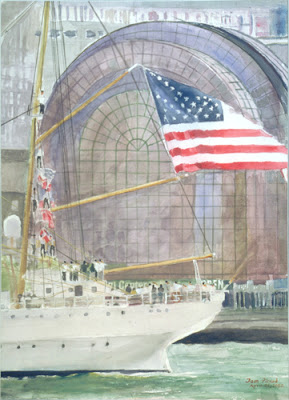
Gloomy Gus GAO says "maritime security" is bright spot in Homeland Security's development:
A report by the U.S. Government Accountability Office, the investigative arm of Congress, says the Department of Homeland Security has failed to meet half its performance expectations since it was established in 2003....Some of the reasons for the improvement is the U.S. Coast Guard, as set out here:
"There were 171 different performance expectations of which we judged that 78 were generally achieved, 83 generally not achieved, and 10 that we did not assess."
The GAO says the Homeland Security Department made the least progress toward some of the fundamental goals set after the 2001 attacks, including improving emergency preparedness and eliminating bureaucratic and technical barriers to information sharing.
The GAO finds moderate progress made in such areas as immigration enforcement, transportation security, and securing critical infrastructure, including bridges and power plants.
The report says the only area where significant progress has been achieved has been in maritime security.
Since September 11, 2001 the Coast Guard has:Picture explanation:
· Created Maritime Safety and Security Team (MSSTs) – federal maritime SWAT teams – highly trained, strategically located, and specially equipped to provide an extra layer of security to key ports, waterways and facilities. Established Special Missions Training Center at Camp Lejeune, N.C. to train new MSSTs and other CG commands in port security.
· Boarded and inspected ships to search for threats and confirm the identity of those aboard.
· Developed special “Sea Marshal” boarding procedures where Coast Guard law enforcement officers remain onboard certain ships as they enter and leave ports to ensure they stay safely on course.
Escorted cruise ships in and out of port and enforced 100-yard “no sail” Security Zones around them.
· Established a new, centralized National Vessel Movement Center and required foreign ships to provide a 96-hour advance notice of arrival plus more information about the ship, cargo, and all people on board – information that is shared with other intelligence and law enforcement agencies to detect threats.
· Established and enforced Naval Protection Zones around all naval vessels. Penalties include forfeiture of vessel, 6 years in prison and $250,000 fine.
· Enforced Security Zones around sensitive maritime areas and facilities.
· Used the pollution and hazardous materials expertise of the of Coast Guard’s National Strike (NSF) to prepare for and respond to bio terrorism response and weapons of mass destruction.
· NSF Atlantic, Pacific and Gulf Strike teams assisted with WTC response, cleanup of Anthrax attacks in Florida and Washington.
· Worked to “push our borders out” to detect threats before they reach our shores. Strengthened our relationships with federal, state, local and international agencies to share information and coordinate security operation.
· Launched a nationwide Port Security Assessment program to review and improve security in 55 key ports and waterways.
· Partnered with mariners and boaters to help keep waterways safe and secure by asking them to be more careful about their own activities on the water, and to be more aware of and report unusual and suspicious activity.
· Maintained the highest level of alert and continued the largest port security effort since WWII.
· Submitted wide range of U.S. security-related proposals to the International Maritime Organization (IMO) to improve security of ships and cargo worldwide, leading U.S. initiative to make global transportation system more secure.
· Launched the first phase of a long-term $17-billion program to build the next generation of Coast Guard ships and aircraft, communications and logistics systems and began some immediate system upgrades that will enable the Coast Guard to perform their essential maritime safety and security missions. Years in the planning and known as the “Deepwater” program because of its focus on larger ships and planes capable of operating far offshore, the contract will strengthen the front line of the Coast Guard's layered homeland security strategy.
· Begun procuring 46 new port security boats around country to enhance patrol and response capabilities of most vital ports.
· Coast Guard Captains of the Port (COTPs) have joined Dept. of Justice Anti-Terrorism Task Forces.
· Coast Guard continues to exercise operational control of 13 U.S. Navy special operations command Patrol Boats for Homeland Security duties, with Coast Guard Law Enforcement Detachments and U.S. Navy crews aboard.
· The coastline is our longest border and we will remain vigilant. (95,000-mile coast includes Great Lakes and inland waterways.)
Approx. 10,000 vessels enter the US each year and make approx. 68,000 port calls.
Coast Guard remains at a heightened state of alert at over 361 major ports.
Coast Guard Investigative Service Special Agents continue to serve as Air Marshals in support of the DOT and FAA. (they are the only military personnel allowed to participate in Air Marshal program).
Over 2,700 Reservists were recalled to active duty· Port Security Units remain on duty in Guantanamo Bay Cuba providing security to JTF 160 at the U.S. Naval Base.
95% of our annual commerce comes by ships through our ports.
Maritime industries contribute $742 billion per year to U.S. Gross National Product.
USCG Eagle Salutes 9/11/01 Tragedy, by Thomas Picard
The Coast Guard training Barque Eagle sails up the Hudson River past the area of the World Trade Center tragedy, saluting as it passes during Fleet Week activities.

No comments:
Post a Comment